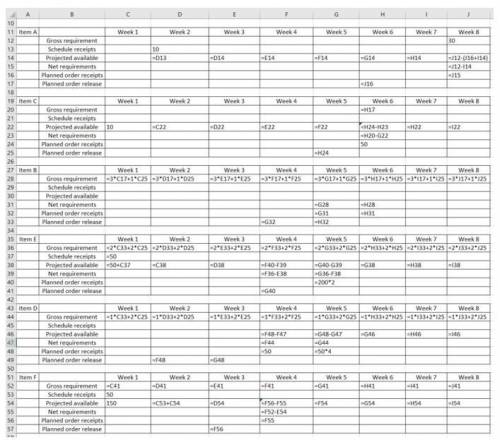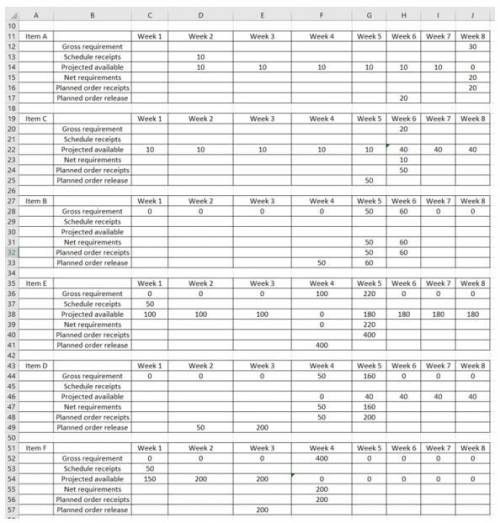
One unit of A is made of three units of B, one unit of C and two units of D. B is composed of two units of E and one unit of D. C is made of one unit of B and two units of E. E is made of one unit of F. Items B, C, E and F have one week lead times; A and D have lead times of two weeks. Assume that lot for lot (L4L) lot sizing is used for Items A, B, and F; lots of size 50, 50, and 200 are used for Items C, D, and E, respectively. Items C, E, and F have on hand (beginning) inventories of 10, 50, and 150, respectively; all other items have zero beginning inventory. We are scheduled to receive 10 units of A in week 2, 50 units of E in week 1, and also 50 units of F in week 1. There are no order scheduled receipts. If 30 units of A are required in week 8, use the low level coded bill of materials to find the necessary planned order releases for all components. Note: Simplify data handling to include the receipt of orders that have actually been placed in previous periods, the following six level scheme can be used. (A number of different techniques are used in practice, but the importance issue is to keep track of what is on hand, what is expected to arrive, what is needed, and what size orders should be placed.) One way to calculate the numbers is as follows:Gross requirementsScheduled receiptsProjected available balanceNet requirementsPlanned order receiptPlanned order release

Answers: 1


Another question on Business

Business, 22.06.2019 21:30
Which of the following best explains the purpose of protectionist trade policies such as tariffs and subsidies? a. they make sure that governments have enough money to pay for fiscal policies. b. they give foreign competitors access to new markets around the world. c. they allow producers to sell their products more cheaply than foreign competitors. d. they enable producers to purchase productive resources from everywhere in the world.
Answers: 1


Business, 23.06.2019 19:30
In the market for widgets, the supply curve is the typical upward-sloping straight line, and the demand curve is the typical downward-sloping straight line. the equilibrium quantity in the market for widgets is 250 per month when there is no tax. then a tax of $6 per widget is imposed. as a result, the government is able to raise $750 per month in tax revenue. we can conclude that the after-tax quantity of widgets has fallen by a. 25 per month. b. 50 per month. c. 75 per month. d. 100 per month.
Answers: 2

Business, 24.06.2019 01:00
Ijust want to feel better. my own body is my deepest enemy. it wants, it wants, it wants and when it does not get, it cries and cries and i punish it. how can you live in fear of your own body?
Answers: 2
You know the right answer?
One unit of A is made of three units of B, one unit of C and two units of D. B is composed of two un...
Questions

Chemistry, 15.07.2019 11:00

Mathematics, 15.07.2019 11:00


Chemistry, 15.07.2019 11:00







Mathematics, 15.07.2019 11:00

Mathematics, 15.07.2019 11:00

Mathematics, 15.07.2019 11:00


Mathematics, 15.07.2019 11:00


Physics, 15.07.2019 11:00







